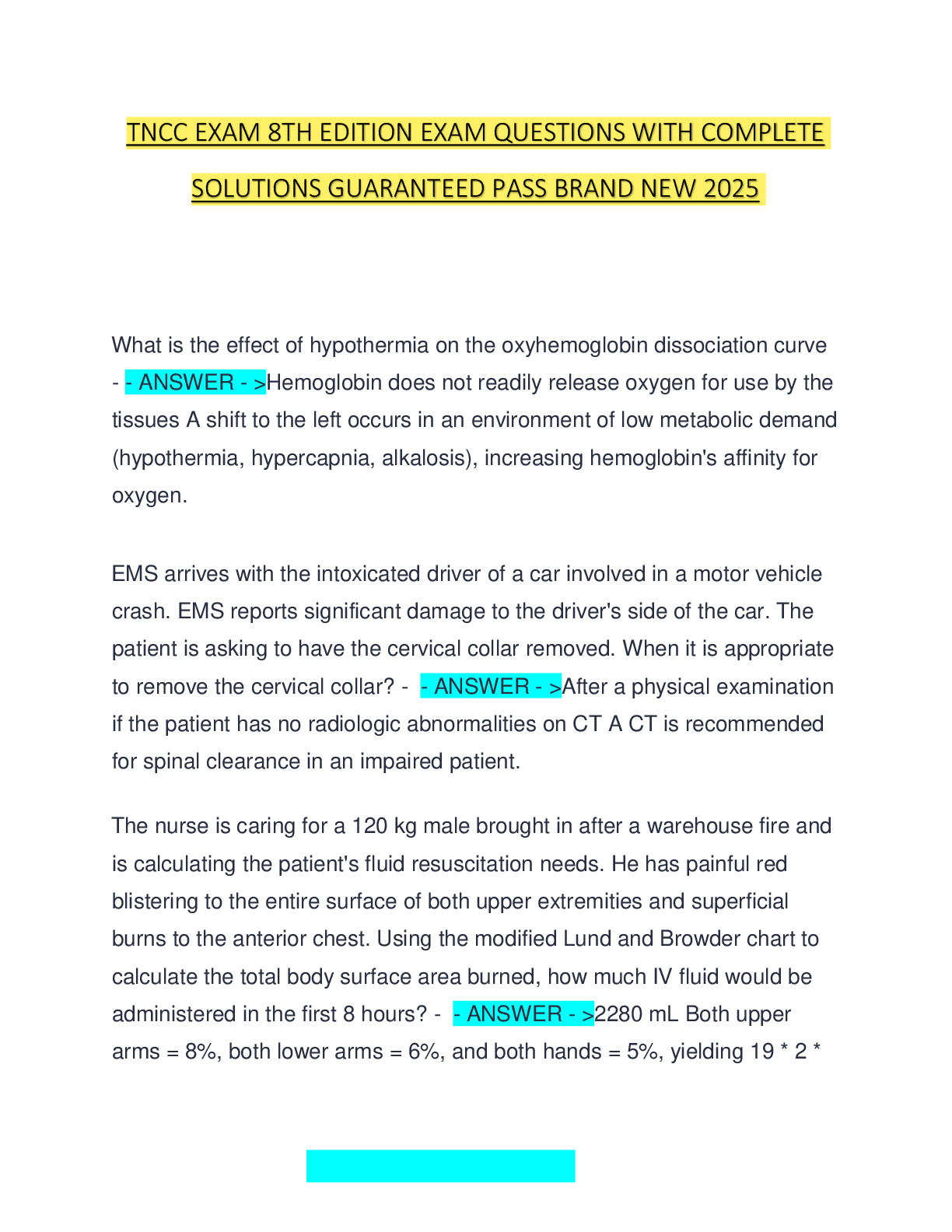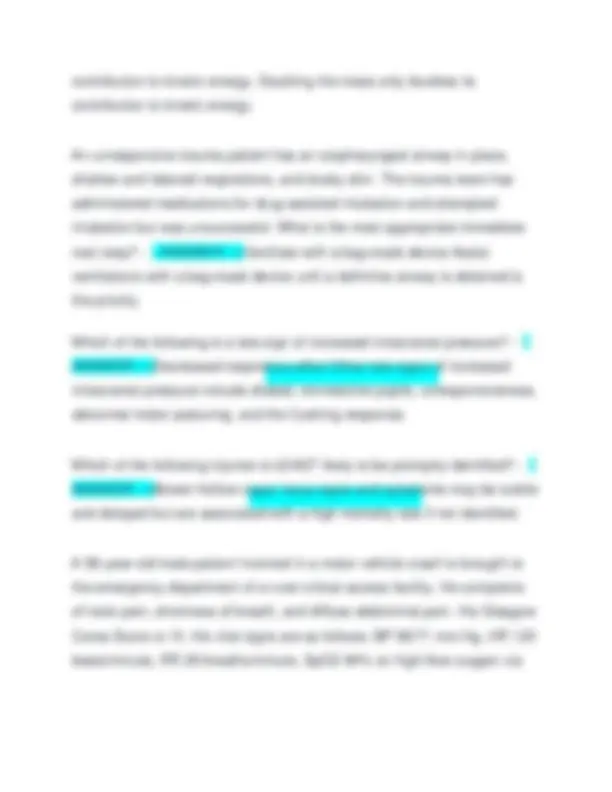


















Study with the several resources on Docsity

Earn points by helping other students or get them with a premium plan


Prepare for your exams
Study with the several resources on Docsity

Earn points to download
Earn points by helping other students or get them with a premium plan
Community
Ask the community for help and clear up your study doubts
Discover the best universities in your country according to Docsity users
Free resources
Download our free guides on studying techniques, anxiety management strategies, and thesis advice from Docsity tutors
TNCC EXAM 8TH EDITION EXAM QUESTIONS WITH COMPLETE SOLUTIONS GUARANTEED PASS BRAND NEW 2025
Typology: Exams
1 / 24

This page cannot be seen from the preview
Don't miss anything!

















What is the effect of hypothermia on the oxyhemoglobin dissociation curve
120 = 4560 mL. Half of the total is equal to 2280 mL. Superficial burns are not included in the TBSA calculation for fluid resuscitation. Which of the following is an expected finding in a patient with a tube thoracotomy connected to a chest drainage system - - ANSWER -
Fluctuation in the water seal chamber Fluctuation in the water seal chamber indicates the tube is placed correctly in the pleural space. .A 35-year-old male presents with facial trauma after being struck in the face with a baseball. A teardrop-shaped left pupil is noted on exam. What type of injury is suspected? - - ANSWER - >Globe rupture A teardrop- shaped pupil suggests a globe rupture. .A patient with a complete spinal cord injury in neurogenic shock will demonstrate hypotension and which other clinical signs? - - ANSWER - Bradycardia and absent motor function below the level of injury Patients with a complete spinal cord injury will have absent motor function below the level of the lesion. They become hypotensive and bradycardic due to loss of autonomic nervous system function. Which of the following patients warrants referral to a burn center? - - ANSWER - >A 52-year-old diabetic male with a partial-thickness burn to the left lower leg This patient has a 7% TBSA burn with a preexisting medical history that could complicate management, prolong recovery, or affect mortality.
part of critical incident stress management but is not considered a critical communication point in trauma care. Which of the following mnemonics can help the nurse prioritize care for a trauma patient with massive uncontrolled hemorrhage? - - ANSWER -
MARCH The MARCH mnemonic stands for massive hemorrhage, airway, respiration, circulation, and head injury/hypothermia. The MARCH mnemonic recognizes uncontrolled hemorrhage as the major cause of preventable death after injury. You are treating a 27-year-old male in respiratory distress who was involved in a house fire. Calculating total body surface area (TBSA) burned is deferred due to the need for emergent intubation. At what rate should you begin fluid resuscitation? - - ANSWER - >500 mL/hour Prior to calculating TBSA, this is the recommended starting point for fluid resuscitation for patients 14 years of age and older A 49-year-old restrained driver involved in a motor vehicle collision presents to the trauma center complaining of abdominal, pelvic, and bilateral lower extremity pain. Vital signs are stable. The nurse can anticipate all of these after a negative FAST exam EXCEPT which of the following? -
An elderly patient with a history of anticoagulant use presents after a fall at home today. She denies any loss of consciousness. She has a hematoma to her forehead and complains of headache, dizziness, and nausea. What is the most likely cause of her symptoms? - - ANSWER - >Subdural hematoma Subdural hematomas are characterized by nausea, vomiting, headache, changes in level of consciousness, ipsilateral dilated, nonreactive pupil, and unilateral weakness or hemiparesis. These typically occur after a fall or assault. Tearing of the bridging veins is most frequently associated with which brain injury? - - ANSWER - >Subdural hematoma Subdural hematomas are usually caused by tearing of the bridging veins and associated with direct injury to the underlying brain tissue. .During the primary survey of an unconscious patient with multi-system trauma, the nurse notes snoring respirations. What priority nursing intervention should be performed next? - - ANSWER - >Insert an oropharyngeal airway if there is no gag reflex Snoring respirations may indicate airway obstruction from the tongue. Insert an airway adjunct to alleviate obstruction by the tongue. Oropharyngeal airways can be used in patients without a gag reflex. What bedside monitoring parameters are used to assess for adequacy of oxygenation and effectiveness of ventilation? - - ANSWER - >Pulse oximetry and capnography Pulse oximetry measures the percentage of hemoglobin saturated with oxygen. Capnography measures the amount of
EMS brings a patient from a motor vehicle crash. Vital signs are BP 90/ mm Hg, heart rate 48 beats/minute, respiratory rate 12 breaths/minute, temperature 97.2°F (36.2° C). The patient exhibits urinary incontinence and priapism. These assessment findings are most consistent with which of the following types of spinal cord injury? - - ANSWER - >Complete Incontinence, priapism, and hypotension with bradycardia are manifestations of a complete spinal cord injury. What physiologic change in the elderly population increases the risk of traumatic injury? - - ANSWER - >Decreased subcutaneous fat Decreased subcutaneous fat and thinning of the skin increases the risk of injuries from soft tissue trauma and increases the risk of hypothermia If a patient has received multiple transfusions of banked blood preserved with citrate, which electrolyte is most likely to drop and require supplementation? - - ANSWER - >Calcium Hypocalcemia is a concern with massive transfusion because citrate is added to banked blood to prevent coagulation. Citrate chelates (binds with) calcium, rendering it inactive. Which of the following is a possible complication of positive-pressure ventilation? - - ANSWER - >Worsening pneumothorax Positive-pressure ventilation can lead to increased air in the chest cavity without a route of escape, worsening a pneumothorax and possibly leading to a tension pneumothorax.
An intubated and sedated patient in the emergency department has multiple extremity injuries with the potential for causing compartment syndrome. What is the most reliable indication of compartment syndrome in a patient who is unconscious? - - ANSWER - >Pressure Pressure can be assessed in the limb by palpation or direct measurement. The compartment or limb will feel tight or tense upon palpation. The skin may also appear taut and shiny. A patient arrives with a large open chest wound after being assaulted with a machete. Prehospital providers placed a nonporous dressing over the chest wound and taped it on three sides. He is now showing signs of anxiety, restlessness, severe respiratory distress, cyanosis and decreasing blood pressure. Which of the following is the MOST appropriate immediate intervention? - - ANSWER - >Dressing removal This is the fastest effective intervention for this decompensating patient. A nonporous dressing taped on three sides is temporary and has variable effectiveness. If signs and symptoms of tension pneumothorax develop after the application of the dressing Which of the following is a component of the trauma triad of death? - - ANSWER - >Acidosis The three components of the trauma triad of death are acidosis, hypothermia and coagulopathy. When is the tertiary survey completed for a trauma patient? - - ANSWER -
Within 24 hours of the trauma The tertiary survey consists of a complete
following is the priority nursing intervention? - - ANSWER - >Elevating the extremity to the level of the heart Elevating the extremity higher than the heart can reduce circulation and tissue perfusion if compartment syndrome is suspected. Which of the following pulse pressures indicate early hypovolemic shock? -
A toddler who fell off a trampoline is making eye contact with the family and is consolable. There is no increased work of breathing and the skin color is pink. The nurse asks the patient to open his mouth, but the patient does not respond to commands. The nurse recognizes this as an expected finding due to which of the following conditions? - - ANSWER -
Developmental stage An alert or older infant or toddler will recognize his or her caregiver but be cautious of strangers and my not respond to commands This is normal. There has been a mass casualty incident a block from the hospital. The hospital is receiving dozens of patients. A truck arrives with an unresponsive patient in the back with obvious chest and abdominal trauma. Agonal respirations do not improve with airway positioning. Using the START triage algorithm, you would triage tag this patient as which of the following? - - ANSWER - >Black This patient is unlikely to survive given the severity of their injuries and is triaged as expectant. Resources should be reserved for individuals considered to be more salvageable. A patient has been in the emergency department for several hours waiting to be admitted. He sustained multiple rib fractures and a femur fracture after a fall. He has been awake, alert, and complaining of leg pain. His wife reported that he suddenly became anxious and confused. Upon reassessment, the patient is restless with respiratory distress and petechiae to his neck. The patient is exhibiting signs and symptoms most commonly associated with which of the following conditions? - - ANSWER
contribution to kinetic energy. Doubling the mass only doubles its contribution to kinetic energy. An unresponsive trauma patient has an oropharyngeal airway in place, shallow and labored respirations, and dusky skin. The trauma team has administered medications for drug-assisted intubation and attempted intubation but was unsuccessful. What is the most appropriate immediate next step? - - ANSWER - >Ventilate with a bag-mask device Assist ventilations with a bag-mask device until a definitive airway is obtained is the priority. Which of the following is a late sign of increased intracranial pressure? - - ANSWER - >Decreased respiratory effort Other late signs of increased intracranial pressure include dilated, nonreactive pupils, unresponsiveness, abnormal motor posturing, and the Cushing response. Which of the following injuries is LEAST likely to be promptly identified? - - ANSWER - >Bowel Hollow organ injury signs and symptoms may be subtle and delayed but are associated with a high mortality rate if not identified. A 56-year-old male patient involved in a motor vehicle crash is brought to the emergency department of a rural critical access facility. He complains of neck pain, shortness of breath, and diffuse abdominal pain. His Glasgow Coma Score is 15. His vital signs are as follows: BP 98/71 mm Hg, HR 125 beats/minute, RR 26 breaths/minute, SpO2 94% on high-flow oxygen via
nonrebreather mask. Which of the following is the priority intervention for this patient? - - ANSWER - > Expedite transfer to the closest trauma center The American College of Surgeons recommends that patients with significant injuries be transported to a trauma center for definitive care. This patient's injuries might not be definitively diagnosed, but his symptoms and vital signs indicate the need for Which of the following is most likely to contribute to inadequate oxygenation and ventilation? - - ANSWER - >Advanced age Older patients are more likely to have pulmonary comorbidities and decreased pulmonary reserve. Which of the following assessment findings differentiates a tension pneumothorax from a simple pneumothorax? - - ANSWER - >Hypotension that worsens with inspiration Hypotension that worsens with inspiration is associated with tension pneumothorax due to compression of the heart and great vessels (obstructive shock). The increased intrathoracic pressure with inspiration worsens the hypotension. What are the greatest risks for transport? - - ANSWER - >Loss of airway patency, displaced obstructive tubes lines or catheters, dislodge splinting devices, need to replace or reinforce dressings, deterioration in patient status change in vital signs or level of consciousness, injury to the patient and/or team members
What is combined loading? - - ANSWER - >Any combination of tension compression torsion bending and/or shear. What are the four types of trauma related injuries? -
What causes the primary effects of blast traumas? - - ANSWER - >The direct blast effects. Types of injuries include last long, tympanic membrane rupture and middle ear damage, abdominal hemorrhage and perforation, global rupture, mild Trumatic brain injury. What causes the secondary effects of blast traumas? - - ANSWER -
Projectiles propelled by the explosion. Injuries include penetrating or blunt injuries or I penetration. What causes the tertiary effects of blast traumas? - - ANSWER - >Results from individuals being thrown by the blast wind. Injuries include hole or partial body translocation from being thrown against a hard service: blunt or penetrating trauma's, fractures, traumatic amputations. What causes quarternary effects of blast traumas? - - ANSWER - >All explosion related injuries, illnesses, or diseases not due to the first three mechanisms. Injuries include external and internal burns, crush injuries, closed and open brain injuries, asthmatic or breathing problems from dust smoke or toxic fumes, angina, or hyper glycemia and hypertension. What causes quinary effects of blasts traumas? -
Name the three ways to confirm ETT placement -
Increasing the ventilation rate. Doing so would allow the patient to blow off retained CO2. When capnography measurement reads less than 35MMHG, the nurse should consider increasing or decreasing the ventilation rate? - - ANSWER - >Decreasing the ventilation rate. By doing so, the nurse allows the patient to retain CO2. What are the three stages of shock - CORRECT ANSWER Compensated, decompensated or progressive, and irreversible. What are the signs of compensated shock? - - ANSWER - >Anxiety, confusion, restlessness, increased respiratory rate, narrowing pulse pressure were diastolic increases yet systolic remains unchanged, tachycardia with bounding pulses, and decreased urinary output What are the signs and symptoms of decompensated shock? - - ANSWER - >Decreased level of consciousness, hypertension, narrow pulse pressure, tachycardia with weak pulses, tachypnea, skin that is cool clammy and
cyanotic, base access outside the normal range, and serum lactate levels greater than two to 4MMOL/L. What are the signs and symptoms of irreversible shock? - - ANSWER -
Obtunded stuporous or comatose state, marked hypertension and heart failure, bradycardia with possible dysrhythmias, decreased and shallow respiratory rate, pale cool and clammy skin, kidney liver and other organ failure, severe acidosis, elevated lactic acid levels, worsening base access on ABGs, coagulopathies with petechiae purpura or bleeding. What are the four types of shock? - - ANSWER - > Hypovolemic, Cardiogenic, Obstructive, & Distributive What is the trauma triad of death? - - ANSWER - >hypothermia, acidosis, coagulopathy Describe the characteristics of obstructive shock -